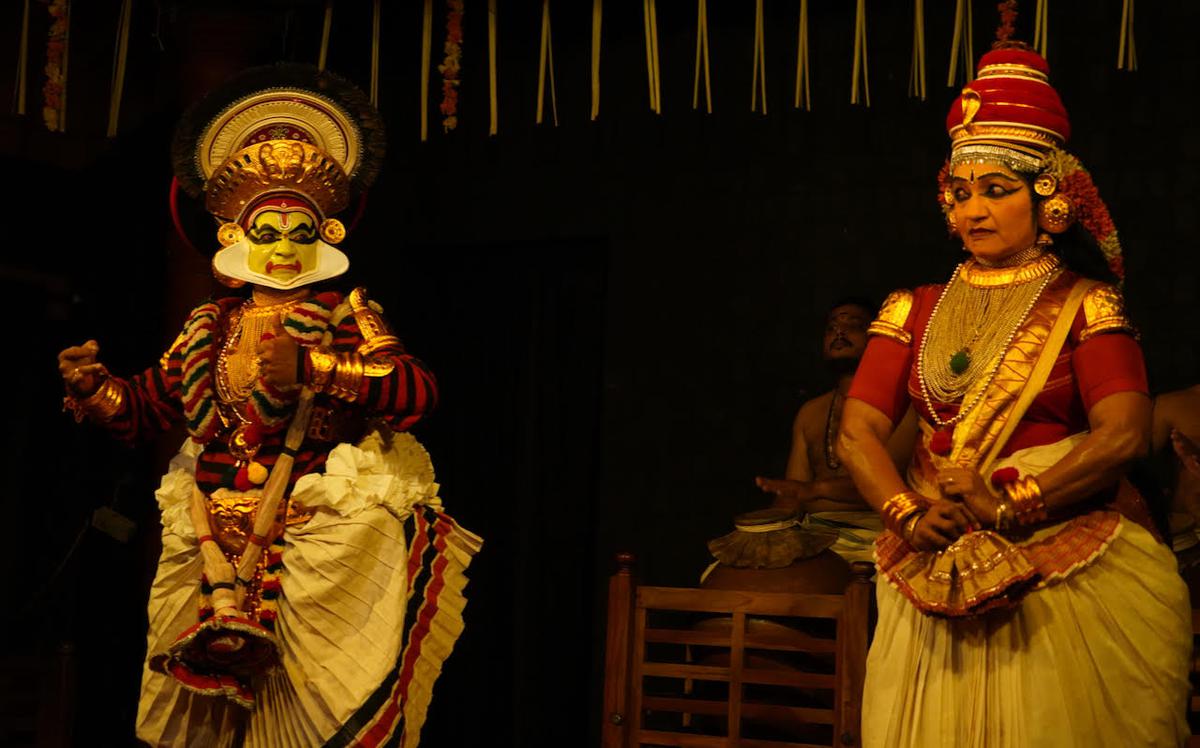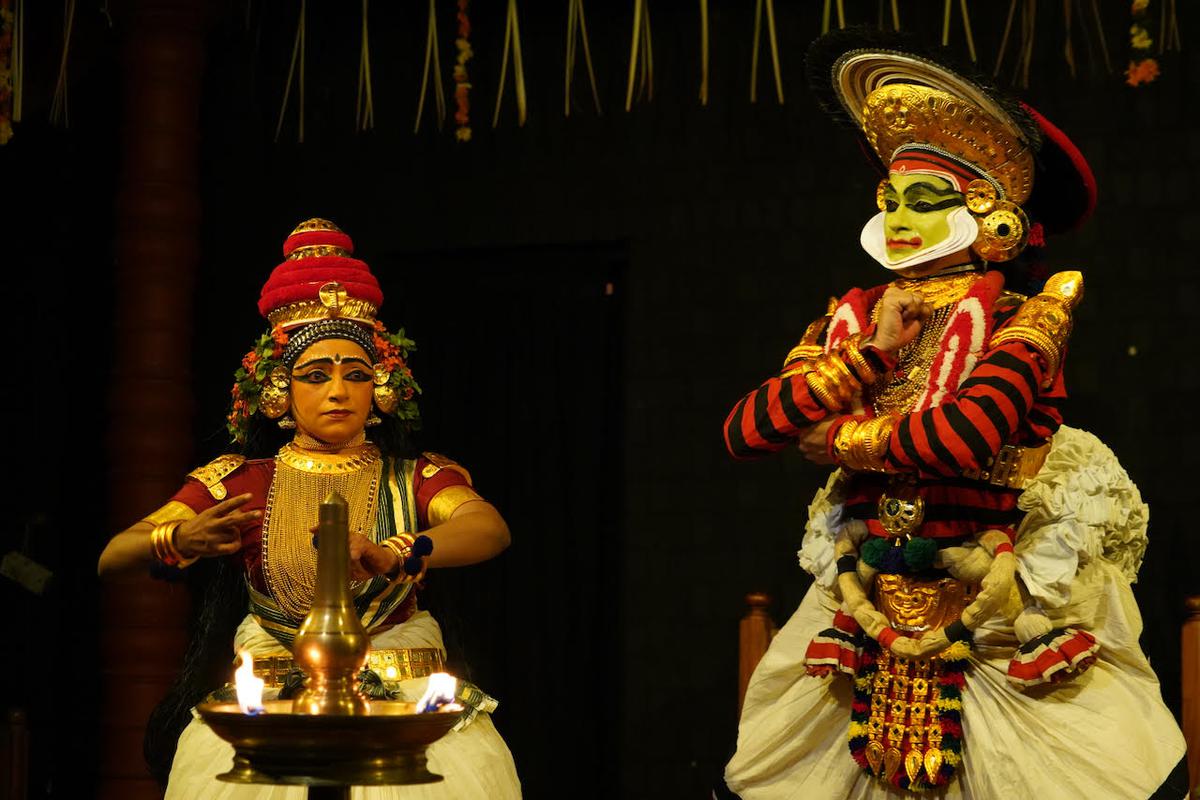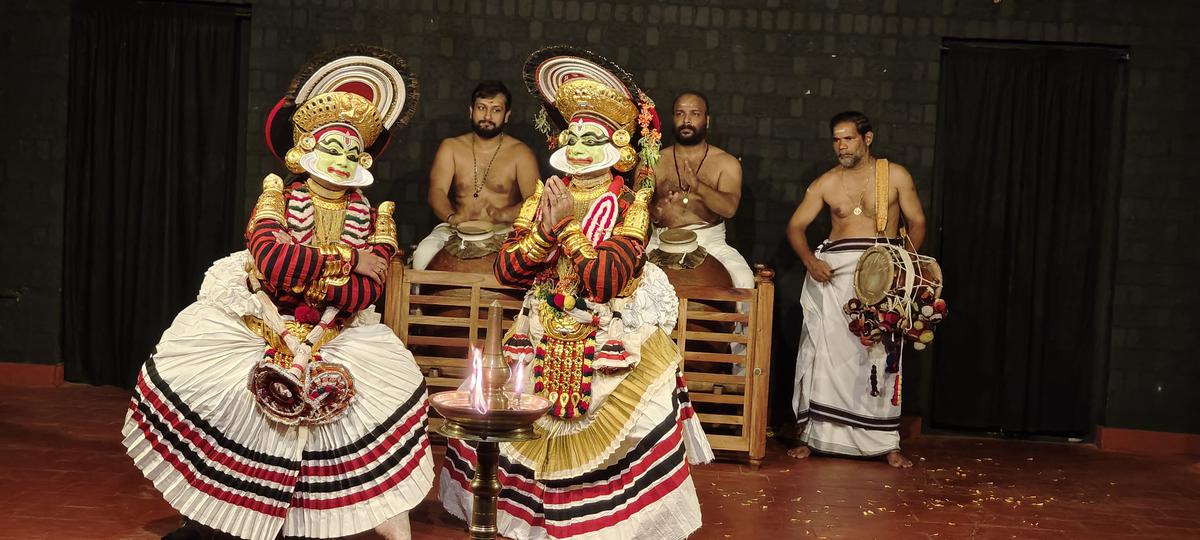A festival that showed why Koodiyattam has captured the attention of the theatre fraternity the world over
Gurusmarana Koodiyattam Festival at Ammannur Gurukulam in Irinjalakuda — with attaprakaram or acting manuals written by the late maestro Ammannur Madhava Chakyar as its theme — was a walk down memory lane that unearthed some rare gems. The five-day annual festival, apart being an aesthetic experience, also revealed why this ancient theatre, while not a popular artform of the masses, has captured the attention of the theatre fraternity the world over.
One of the extraordinary features of Koodiyattam is that the playwright and the text take second billing to the actor and the attaprakaram created by the guru. The text is only the starting point and the creator of the acting manual adds perspective, character background, and verses from external sources with strong acting potential. In the process the acting manual expands in heft with the playwright’s original text forming only a small but integral part.
Moreover, in the hands of a talented actor, the attaprakaram expands further when he or she imaginatively taps into the acting opportunities provided in it. No wonder, a play like Ascharyachoodamani (wondrous Crest Jewel), written by Sakthibhadran, believed to have lived between the 7th and 11th centuries, takes over 100 days to perform its seven acts in full.

Margi Madhu as Lakshmana and Usha Nangiar as Lalitha (Soorpanakha in disguise).
| Photo Credit:
Achutan T.K.
As Koodiyattam scholar K. G. Paulose said in his talk at the festival, the role of the actor in Koodiyattam is not to narrate the story but to convey the internal thought processes and feelings of the character to the audience. It is precisely this facet of the artform that was highlighted on the opening day that featured a small section of Parnasalankam, Act One of Ascharyachoodamani . The context is Ravana’s sister Soorpanakha wandering around looking for a husband. She falls for the handsome Rama, disguises herself as a beautiful woman (Lalita), and approaches him. Rama in turn sends her to Lakshmana.
Excellent portrayal
Senior artists Margi Madhu as Lakshmana and Usha Nangiar as Lalita left deep impressions. This is not an easy act as the characters of Lakshmana and Soorpanakha are trying to outwit the other, and do not necessarily mean what they say. This contradiction was conveyed subtly by both Madhu and Usha.
Soorpanakha in Usha’s hands is not a revolting demoness but emerges as a clever woman deserving of our empathy.
An outstanding passage was Madhu as Lakshmana trying to shoo away Soorpanakha by narrating to her the rigours of life in the forest. His portrayal of trying to sleep sitting on a tree branch, lightning bolts and getting drenched in rain was an acting lesson on how to use one’s body.
The programme line up at the festival also threw light on the sophistication of the theatrical devices and acting techniques used in this 1000-year-old artform.

Kapila Venu as Sita and Sooraj Nambiar as Lakshmana.
| Photo Credit:
Achutan T.K.
Both Mayaseethankam, featured in two parts, and Agnipravesankam on the final day revealed how imaginative flourishes of the playwright and the creative interpolations of the attaprakaram creator combine to enhance the theatrical experience. Digressions from the original epic, creating new characters, descriptive commentaries to convey dramatic events and substantial roles for women — that have always been performed only by women — were all on display here.

Margi Sajeev Narayana Chakyar as Ascharyalakshmana.
| Photo Credit:
Sibin
Dramatic narrative
For example a scene from Mayaseethankam had two sets of Rama and Sita — one illusory and one real — on stage at the same time. Pairing the real Sita with an illusory Rama (Ravana) in an airborne chariot and a fake Sita (Soorpanakha) with the real Rama on the ground provided some twists and heightened the dramatic narrative of the abduction of Sita.
Apart from Usha Nangiar, two other strong female roles were presented by Kapila Venu as Sita and Saritha Krishnakumar as the illusory Sita in Mayaseethankam Part 1 and 2 respectively. Sita’s anxiety about Rama that resulted in cruel accusations against Lakshmana, and the latter’s helplessness, were brought to life beautifully by Kapila and Sooraj Nambiar. The seasoned actors ensured that this emotional duel didn’t sink into melodrama. It was Saritha as the illusory Sita (Soorpanakha) who stood out in Mayaseethankam Part 2. Her complicity in the kidnap and finally seeking Rama’s help for an escape route was convincingly portrayed by Sarita. Their dialogues may have been brief, but their presence on stage was strong and impactful.
Impactful scene
The festival concluded with Agnipravesankam, which centres around Sita’s test by fire ordered by Rama to prove her purity. The scene comes alive vividly thanks to the playwright’s inventiveness in making Lakshmana narrate the incident. Without any props or special effects, without even showing Sita, the audience feels the magnitude of the event.
Ascharya Lakshmana, or Wonderstruck Lakshmana as he is called in this scene, details how Sita entered the fire without any fear or rancour, how gods showered flowers from heaven and how Lord Agni led Sita out of the fire. With surprise written all over his face, excitement evident in his footwork and the cadence of the dialogues, Margi Sajeev Narayana Chakyar as Lakshmana conveyed the thrill of witnessing this extraordinary experience of Sita emerging unscathed from fire.
Onus on the dramaturg
A talk on Post-Dramatic Theatre, which focuses on theatre beyond the text and moves from author-centric to a collective effort, provided an interesting sense of deja vu. Sreejith Ramanan, Head, Department of Theatre, School of Drama and Fine Arts in Thrissur, said that in today’s post-dramatic theatre, the creative lead in a play is not with the playwright, nor with the director, but with the dramaturg. Perhaps something very similar to what our Koodiyattam guru has been doing in his kalari over a thousand years ago.
For all the latest Entertainment News Click Here
For the latest news and updates, follow us on Google News.
